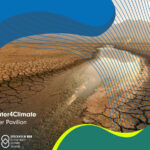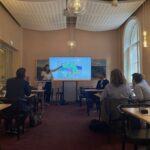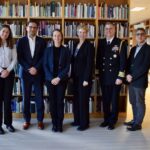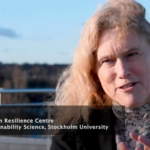Download PDF: An Agenda on Environment, Climate and Security: Ways Forward
The world is facing multiple major intertwined crises that will demand major societal transitions. Not least, the war in Ukraine has put into question the long-held beliefs, especially among Western governments, that economic and energy interdependence is a major factor for stability and a cornerstone of 77 years of a relatively stable global security architecture of peace. This crisis comes directly on the back of a multiyear pandemic that revealed not only the connectivity of today’s world and societies but also how our unhealthy relationship with nature can cause major global disruptions. These two crises have overshadowed the even larger environmental crisis looming in the background: climate change and biodiversity loss.
The impact of human-induced climate change is already noticeable in ‘weather and climate extremes in every region across the globe’ as noted in the 2021 Intergovernmental Panel on Climate Change (IPCC) report on The Physical Science Basis. Indeed, at the current rate of climate change the aims of the Paris Agreement to keep global warming well below 2 degrees are in question. The IPCC notes, ‘Global warming of 1.5°C and 2°C will be exceeded during the 21st century unless deep reductions in carbon dioxide (CO2 ) and other greenhouse gas emissions occur in the coming decades.’ The latest IPCC report Impacts, Adaptation and Vulnerability, published in February 2022, unequivocally states that ‘any further delay in concerted anticipatory global action on adaptation and mitigation will miss a brief and rapidly closing window of opportunity to secure a livable and sustainable future for all.’
With action being insufficient and climate change already affecting weather and generating extreme events, there is increased recognition that the interconnected challenges of environmental degradation, climate change and conflict are compounding the hardship of already highly vulnerable populations, including an increased risk of conflict. These dynamics are not limited to anthropogenic climate change alone but also relate to broader environmental implications, such as biodiversity loss. As species are lost, resilience is progressively (and many times silently) eroded, risking sudden losses of these key ecosystem functions and services with detrimental impacts to local livelihoods and human security. Several local communities across the world are highly dependent of local ecosystem services and natural resources, and their depletion leads to sharp increases in food insecurity, decreased health and nutrition, and intra and intercommunity conflicts over these resources.
Thus, we find ourselves in a new risk landscape that is the result of massive human-driven changes to the Earth system and is fuelled by unprecedented levels of hyper-connectivity that characterize the Anthropocene. Events such as pandemics, financial crashes and synchronized food shocks spread more rapidly than in the past—and with greater geographic spread. These shocks intersect with one another and are confronting governments and practitioners with a changing social, political and economic landscape. Groundwater—which provides half of all drinking water, more than 40% of irrigation water and one third of the industrial sector’s global need for water—is a case in point. Some 2.5 billion people depend solely on this resource to satisfy their daily needs. Most of the world’s large aquifers cross international borders and some 470 transboundary aquifers have been identified. Nonetheless, transboundary groundwater and surface water systems tend to be managed under different regimes, and little is known about groundwater scarcity and conflict prevention. Only seven international, bilateral or multilateral treaties on transboundary aquifers exist, in contrast to more than 200 surface water-oriented treaties. Collaborative arrangements require data, information and knowledge about this invisible resource, and the exchange of such. However, gathering of data is costly and lack of capacity impedes progress in this field.
At the same time we need to transform our societies for climate and security reasons, as well as to avoid other systemic risks (e.g. away from fossil fuel dependency), as the Ukraine crisis has demonstratively shown. But what will this transition entail? What are the risks if economic and energy interdependencies, that were believed to be stabilizing and critical for peace between states, are exchanged for more sustainable, but at times are more autarkic and local systems?
Navigating a complex and interconnected world
So, how to navigate this new, complex, and interconnected world? The United Nations Development Programme (UNDP) Human Security Report 2022 stresses that ‘efforts remain largely compartmentalized, dealing separately with climate change, biodiversity loss, conflicts, migration, refugees, pandemics and data protection. Those efforts should be strengthened but tackling them in silos appears insufficient in the Anthropocene context.’ Cooperation and joint knowledge production between different research communities inevitably produces new insights and strategies to adequately respond and support policy actors to rise to the challenge.
Each of the institutions involved in the Stockholm Hub on Environment, Climate and Security is world leading in its own right. The Stockholm Hub’s interdisciplinary setup provides a unique added value and opportunity to explore the ways in which climate and environmental change leads to human insecurities and undermines sustainable, just, resilient and peaceful societies.
Sweden plays a leading role on environment, climate and security issues on the international stage, underpinned by active and forward-leaning efforts to develop policies and build resilience and preparedness by national agencies, authorities and organizations. The Hub aims to inspire and support this work by providing a platform that enhances cooperation. By breaking down silos and fostering synergies, Sweden and Swedish stakeholders can become even more effective in their innovation and leadership, both domestically and globally.
Against this backdrop, the Hub engages in four research areas, to generate new insight and develop new research agendas that are needed in today’s world.
Biodiversity
Human development and security depend on safeguarding the stability of the planet. Current human activities, especially of high-consuming wealthy societies, are threatening the stability of Earth’s life support systems and its capacity to support our future well-being. Earth’s biosphere—its extraordinary diversity of species and ecosystems on land and in the oceans—drives the life-sustaining cycles of water and other materials that enable all life on Earth to thrive. The biosphere has also played a central role in keeping our planet’s climate system unusually stable throughout the past 11,700 years.
Biodiversity plays a key role in underpinning biosphere resilience. Resilience is the capacity of a natural system to cope and adapt in the face of changing social or environmental conditions. The loss of biodiversity and resilience can very often lead to tipping points being crossed and sudden, catastrophic and almost irreversible changes occurring. These types of events are often referred to as ‘regime shifts’ and they can have substantial impacts on human societies and economies and are often difficult to anticipate. The past decade has seen mounting evidence that climate- and biodiversity-related tipping points can occur on the scale of the Earth system and that crossing these exposes the world to serious changes.
The Stockholm Hub will contribute to a better understanding of how the combined effects of biodiversity loss and climate change can lead to thresholds and tipping points being crossed in the Earth’s biosphere, and how these can pose a primary threat to human security.
Just resilience
In a globalizing world, countries’ economies and the resources they depend on are connected through trade, financial flows, the movement of people and shared biophysical systems, such as river basins. That means that shocks or stresses in one country can be felt, and sometimes made worse, in other countries thousands of kilometers away. For example, during the global food price crisis of 2007–2008, multiple factors—including oil prices, extreme weather, changes in food demand, trade policies and government responses to the unfolding crisis—all interacted to generate a surge in global food prices, creating food insecurity for vulnerable communities worldwide.
Situations like this, which climate change is exacerbating, directly affect human security and can fuel latent conflicts. When people are hungry and desperate, especially in the absence of good governance and safety-net programmes, tensions may escalate, and affected communities may also become very vulnerable to exploitation by criminal networks or armed groups.
A just transition for climate change adaptation is therefore crucial to ensuring both human well-being and countries’ security, as resource scarcity and other stresses caused by climate change or by maladaptation can exacerbate conflict and even indirectly fuel violence. The Stockholm Hub has proposed a framework for a just transition for adaptation, focused on two dimensions: justice (procedural and distributional) and connectedness. Achieving global just resilience requires addressing both dimensions together. Multilateral cooperation is essential, requiring the strengthening of climate diplomacy for adaptation. It should move beyond discussions of finance provision to meaningfully incorporate equity and human security. It should also include actors across sectors and scales which have not traditionally been involved in adaptation but are central to international cooperation.
Climate security and climate institutions
Fragile and conflict-affected states are highly vulnerable to the effects of climate change. Climate finance, for both adaptation and mitigation, can help to build resilience and prepare countries to cope with the effects of climate change. It can also help to enable co-benefits, such as reducing tensions over natural resources and positively contributing to peace. However, recent UNDP research has found that fragile and conflict-affected countries most in need of climate finance are also the ones less reached by international (public) financial flows. Several factors have been found to limit access of fragile states to climate finance. Less attention seems to have been paid to the effectiveness of the climate finance that went to fragile states, or the extent to which these funds contributed to conflict-sensitive or peace-positive activities.
The Stockholm Hub will look in detail at climate finance to fragile and conflict-affected states to understand the extent to which these financial flows contribute to conflictsensitive and peace-positive climate resilience.
Information influence campaigns
While political will is one problem, the role of information influence campaigns about the causes and impacts of climate change and the implementation of climate agreements has security implications. The impact of misinformation, disinformation and ‘malinformation’ on climate negotiations and climate adaptation leads to polarization and erodes trust in climate science. The very issue of climate change has been subjected to organized disinformation campaigns and different actors have skewed the climate change narrative based on their political and security needs and interests. How messages about climate-related security risks, the need for just transition and adaptation, and climate change at large are shared has an impact. Information influence campaigns thrive in the current public communication environment: 25% of tweets about climate crisis are produced by bots, and a study estimated that 35% of the accounts that tweeted about the 2018 United Nations Framework Convention on Climate Change (UNFCCC) summit in Katowice were bots. Climate misinformation surges following UNFCCC meetings, including the 2021 UNFCCC meeting in Glasgow.
The Stockholm Hub will contribute to a better understanding of this dynamic by both researching the impact of information influence campaigns on climate-related security risks and by providing recommendations to Swedish stakeholders on how to change the environment and communication landscape where information influence campaigns thrive.






